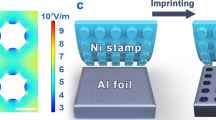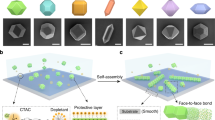Abstract
Several physico-chemical effects and properties in the solid state involve nanoscale interactions between adjacent materials and morphologies. Arrays of binary nanostructures can generate intimate interactions between different sub-components, but fabricating binary nanostructures is challenging. Here, we propose a concept to achieve diverse binary nanostructure arrays with high degrees of controllability for each of the sub-components, including material, dimension and morphology. This binary nanostructuring concept originates with a distinctive binary-pore anodized aluminium oxide template that includes two dissimilar sets of pores in one matrix, where the openings of the two sets of pores are towards opposite sides of the template. Using the same growth mechanism, the binary-pore template can be extended to multi-pore templates with more geometrical options. We also present photoelectrodes, transistors and plasmonic devices made with our binary nanostructure arrays using different combination of materials and morphologies, and demonstrate superior performances compared to their single-component counterparts.
This is a preview of subscription content, access via your institution
Access options
Subscribe to this journal
Receive 12 print issues and online access
$259.00 per year
only $21.58 per issue
Buy this article
- Purchase on Springer Link
- Instant access to full article PDF
Prices may be subject to local taxes which are calculated during checkout





Similar content being viewed by others
References
Kelzenberg, M. D. et al. Enhanced absorption and carrier collection in Si wire arrays for photovoltaic applications. Nat. Mater. 9, 239–244 (2010).
Luk'yanchuk, B. et al. The Fano resonance in plasmonic nanostructures and metamaterials. Nat. Mater. 9, 707–715 (2010).
Tomioka, K., Yoshimura, M. & Fukui, T. A III–V nanowire channel on silicon for high-performance vertical transistors. Nature 488, 189–192 (2012).
Li, K. H., Liu, X., Wang, Q., Zhao, S. & Mi, Z. Ultralow-threshold electrically injected AlGaN nanowire ultraviolet lasers on Si operating at low temperature. Nat. Nanotech. 10, 140–144 (2015).
Wu, W. Z., Wen, X. N. & Wang, Z. L. Taxel-addressable matrix of vertical-nanowire piezotronic transistors for active and adaptive tactile imaging. Science 340, 952–957 (2013).
Pan, C. F. et al. High-resolution electroluminescent imaging of pressure distribution using a piezoelectric nanowire LED array. Nat. Photon. 7, 752–758 (2013).
Fan, Z. Y. et al. Three-dimensional nanopillar-array photovoltaics on low-cost and flexible substrates. Nat. Mater. 8, 648–653 (2009).
Mubeen, S. et al. An autonomous photosynthetic device in which all charge carriers derive from surface plasmons. Nat. Nanotech. 8, 247–251 (2013).
Wallentin, J. et al. Inp nanowire array solar cells achieving 13.8% efficiency by exceeding the ray optics limit. Science 339, 1057–1060 (2013).
Taberna, L., Mitra, S., Poizot, P., Simon, P. & Tarascon, J. M. High rate capabilities Fe3O4-based Cu nano-architectured electrodes for lithium-ion battery applications. Nat. Mater. 5, 567–573 (2006).
Banerjee, P., Perez, I., Henn-Lecordier, L., Lee, S. B. & Rubloff, G. W. Nanotubular metal–insulator–metal capacitor arrays for energy storage. Nat. Nanotech. 4, 292–296 (2009).
Liu, C. Y. et al. An all-in-one nanopore battery array. Nat. Nanotech. 9, 1031–1039 (2014).
Shevchenko, E. V., Talapin, D. V., Kotov, N. A., O'Brien, S. & Murray, C. B. Structural diversity in binary nanoparticle superlattices. Nature 439, 55–59 (2006).
Dong, A., Chen, J., Vora, P. M., Kikkawa, J. M. & Murray, C. B. Binary nanocrystal superlattice membranes self-assembled at the liquid-air interface. Nature 466, 474–477 (2010).
Ye, X. et al. Structural diversity in binary superlattices self-assembled from polymer-grafted nanocrystals. Nat. Commun. 6, 10052 (2015).
Paik, T., Diroll, B. T., Kagan, C. R. & Murray, C. B. Binary and ternary superlattices self-assembled from colloidal nanodisks and nanorods. J. Am. Chem. Soc. 137, 6662–6669 (2015).
Shegai, T. et al. A bimetallic nanoantenna for directional colour routing. Nat. Commun. 2, 481 (2011).
Li, Z. G. et al. Design and fabrication of ZnO/Ni heterogeneous binary arrays with selective control of structure, size and distance via stepwise colloidal lithography. RSC Adv. 3, 14829–14836 (2013).
Shin, D. O. et al. Multicomponent nanopatterns by directed block copolymer self-assembly. ACS Nano 7, 8899–8907 (2013).
Liu, N., Tang, M. L., Hentschel, M., Giessen, H. & Alivisatos, A. P. Nanoantenna-enhanced gas sensing in a single tailored nanofocus. Nat. Mater. 10, 631–636 (2011).
Jain, T., Aernecke, M., Liberman, V. & Karnik, R. High resolution fabrication of nanostructures using controlled proximity nanostencil lithography. Appl. Phys. Lett. 104, 083117 (2014).
Qin, L. D., Park, S., Huang, L. & Mirkin, C. A. On-wire lithography. Science 309, 113–115 (2005).
Fan, Z. Y. et al. Ordered arrays of dual-diameter nanopillars for maximized optical absorption. Nano Lett. 10, 3823–3827 (2010).
Ozel, T., Bourret, G. R. & Mirkin, C. A. Coaxial lithography. Nat. Nanotech. 10, 319–324 (2015).
Mi, Y. et al. Constructing a AZO/TiO2 core/shell nanocone array with uniformly dispersed Au NPs for enhancing photoelectrochemical water splitting. Adv. Energy Mater. 6, 1501496 (2016).
Lee, W., Ji, R., Gösele, U. & Nielsch, K. Fast fabrication of long-range ordered porous alumina membranes by hard anodization. Nat. Mater. 5, 741–747 (2006).
Lee, W. et al. Structural engineering of nanoporous anodic aluminium oxide by pulse anodization of aluminium. Nat. Nanotech. 3, 234–239 (2008).
Lee, M. H. et al. Roll-to-roll anodization and etching of aluminum foils for high-throughput surface nanotexturing. Nano Lett. 11, 3425–3430 (2011).
Leung, S.-F. et al. Roll-to-roll fabrication of large scale and regular arrays of three-dimensional nanospikes for high efficiency and flexible photovoltaics. Sci. Rep. 4, 4243 (2014).
Masuda, H. et al. Ordered mosaic nanocomposites in anodic porous alumina. Adv. Mater. 15, 161–164 (2003).
Yanagishita, T., Sasaki, M., Nishio, K. & Masuda, H. Carbon nanotubes with a triangular cross-section, fabricated using anodic porous alumina as the template. Adv. Mater. 16, 429–432 (2004).
Smith, J. T., Hang, Q., Franklin, A. D., Janes, D. B. & Sands, T. D. Highly ordered diamond and hybrid triangle–diamond patterns in porous anodic alumina thin films. Appl. Phys. Lett. 93, 043108 (2008).
Wen, L. Y. et al. Cost-effective atomic layer deposition synthesis of Pt nanotube arrays: application for high performance supercapacitor. Small 10, 3162–3168 (2014).
Wang, Z. et al. Manipulation of charge transfer and transport in plasmonic–ferroelectric hybrids for photoelectrochemical applications. Nat. Commun. 7, 10348 (2016).
Lee, W. & Park, S.-J. Porous anodic aluminum oxide: anodization and templated synthesis of functional nanostructures. Chem. Rev. 114, 7487–7556 (2014).
Lei, Y., Cai, W. P. & Wilde, G. Highly ordered nanostructures with tunable size, shape and properties: a new way to surface nano-patterning using ultra-thin alumina masks. Prog. Mater Sci. 52, 465–539 (2007).
Wen, L. Y. et al. Designing heterogeneous 1D nanostructure arrays based on AAO templates for energy applications. Small 11, 3408–3428 (2015).
Masuda, H. et al. Square and triangular nanohole array architectures in anodic alumina. Adv. Mater. 13, 189–192 (2001).
Yang, J. et al. Morphology defects guided pore initiation during the formation of porous anodic alumina. ACS Appl. Mater. Interfaces 6, 2285–2291 (2014).
Garcia-Vergara, S. J., Skeldon, P., Thompson, G. E. & Habazaki, H. A flow model of porous anodic film growth on aluminium. Electrochim. Acta 52, 681–687 (2006).
Hebert, K. R., Albu, S. P., Paramasivam, I. & Schmuki, P. Morphological instability leading to formation of porous anodic oxide films. Nat. Mater 11, 162–166 (2012).
Oh, J. & Thompson, C. V. The role of electric field in pore formation during aluminum anodization. Electrochim. Acta 56, 4044–4051 (2011).
Walter, M. G. et al. Solar water splitting cells. Chem. Rev. 110, 6446–6473 (2010).
Liu, C., Tang, J. Y., Chen, H. M., Liu, B. & Yang, P. D. A fully integrated nanosystem of semiconductor nanowires for direct solar water splitting. Nano Lett. 13, 2989–2992 (2013).
Giannini, V., Fernandez-Dominguez, A. I., Heck, S. C. & Maier, S. A. Plasmonic nanoantennas: fundamentals and their use in controlling the radiative properties of nanoemitters. Chem. Rev. 111, 3888–3912 (2011).
Long, J. W., Dunn, B., Rolison, D. R. & White, H. S. Three-dimensional battery architectures. Chem. Rev. 104, 4463–4492 (2004).
Parkhutik, V. P. & Shershulsky, V. I. Theoretical modeling of porous oxide-growth on aluminum. J. Phys. D 25, 1258–1263 (1992).
Li, D. D., Zhao, L. A., Jiang, C. H. & Lu, J. G. Formation of anodic aluminum oxide with serrated nanochannels. Nano Lett. 10, 2766–2771 (2010).
Acknowledgements
This work is supported by a European Research Council Grant (ThreeDSurface 240144), a European Research Council PoC Grant (HiNaPc, 737616), the Federal Ministry of Education and Research in Germany (BMBF: ZIK-3DNano-Device, 03Z1MN11) and the German Research Foundation (DFG, LE 2249_4–1). The authors thank R. Henry for help with FIB milling and TEM imaging, and S. H. Si and M. Breiter for help with the RIE process. The authors thank T. Hannappel for use of multi-tip scanning tunnelling microscopy equipment. The authors also thank Z. J. Wang, H. P. Zhao, D. W. Cao and M. Sommerfeld for technical support and discussions.
Author information
Authors and Affiliations
Contributions
L.W. and Y.L. conceived the concept. Y.L. supervised the project. L.W., R.X. and Y.M. prepared the materials, conducted the experiments and collected the data. L.W. analysed the date. L.W and Y.L. wrote the manuscript. All authors discussed the results and commented on the manuscript.
Corresponding author
Ethics declarations
Competing interests
The authors declare no competing financial interests.
Supplementary information
Supplementary information
Supplementary information (PDF 7157 kb)
Rights and permissions
About this article
Cite this article
Wen, L., Xu, R., Mi, Y. et al. Multiple nanostructures based on anodized aluminium oxide templates. Nature Nanotech 12, 244–250 (2017). https://doi.org/10.1038/nnano.2016.257
Received:
Accepted:
Published:
Issue Date:
DOI: https://doi.org/10.1038/nnano.2016.257
This article is cited by
-
Efficient osmosis-powered production of green hydrogen
Nature Sustainability (2024)
-
Well-defined nanostructuring with designable anodic aluminum oxide template
Nature Communications (2022)
-
Signatures of a strange metal in a bosonic system
Nature (2022)
-
A Review of Nonaqueous Electrolytes, Binders, and Separators for Lithium-Ion Batteries
Electrochemical Energy Reviews (2022)
-
Capillary Performance of Nanoporous Aluminum Braided Wicks Prepared by Anodic Oxidation
Nanomanufacturing and Metrology (2022)



